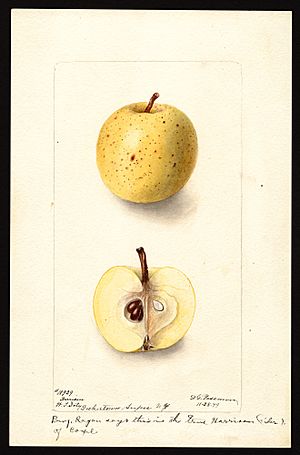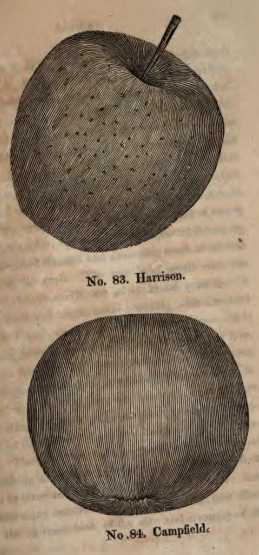Harrison Cider Apple facts for kids
Quick facts for kids 'Harrison' apple |
|
|---|---|
 |
|
| Genus | Malus |
| Species | Malus domestica |
| Cultivar | 'Harrison' |
The Harrison cider apple is a special kind of apple that was once very famous for making apple cider. It grew in New Jersey a long time ago, even before the American Revolution. For a while, people thought this apple was gone forever. But guess what? It was found again in 1976 in Livingston, New Jersey! Today, it's used again to make delicious cider.
A Look Back at the 'Harrison' Apple
In 1817, a man named William Coxe wrote an important book about fruits grown in North America. He described the Harrison apple, calling it the most famous cider apple from Newark, New Jersey.
He said the apple was:
- Shaped a bit long and pointy at the top.
- Had a long stem, which is why some called it the "long stem" apple.
- Its skin was yellow with many black spots, making it feel a bit rough.
- The inside was rich, yellow, firm, and a little tough.
- It tasted pleasant and lively, but a bit dry.
Coxe also noted that the Harrison apple made a strong, sweet, and richly colored cider. This cider was so good that it sold for a high price in New York! The apple trees were reliable, meaning they always produced a good crop. The apples usually fell around November 1st. They were smaller than average but didn't rot easily and could be stored well. The trees themselves grew strong and healthy. The apple got its name from a family in Essex County, New Jersey, where it first grew.
Many of the apples, pears, and other fruits grown in North America today came from the types described in Coxe's book. Even though many fruit types came from Europe, Coxe believed that new American varieties were better because they grew well in the American climate and soil.
By the early 1900s, the Harrison apple was almost forgotten. When "The Apples of New York" was written in 1905, the Harrison wasn't even mentioned. This happened mainly because of the temperance movement, which started in the 1820s. This movement encouraged people to drink less alcohol, which meant less demand for cider apples.
Rediscovering the 'Harrison' Apple
In September 1976, a fruit collector from Vermont went looking for the Harrison apple in Essex County, New Jersey. On September 25, he found an old cider mill in Livingston, New Jersey. The owner of the mill had a Harrison apple tree in his backyard! The owner said his grandfather had planted the tree around 1900.
This old tree was about to be cut down to make space for a vegetable garden. Luckily, the collector saw it just in time! The tree was full of small yellow apples that matched William Coxe's old description. The collector quickly took some small branches, called scions, from the tree to save them. Less than a week later, the tree was cut down.
In the spring of 1977, these scions were used to start new Harrison apple trees. This process is called grafting, where a piece of one plant is joined to another to grow a new plant.
In 1980, the news about finding the Harrison apple (and another apple called 'Campfield') was shared with others. Later, in 1992, trees, fruit, and scions of the Harrison apple were sent to Thomas Burford in Virginia. He was a respected expert on old, special apple varieties called heirloom apples.
Thanks to these efforts, the Harrison cider apple is now widely available again! For example, Ironbound Hard Cider uses Harrison apples to make its cider on a large farm in Asbury, New Jersey.


